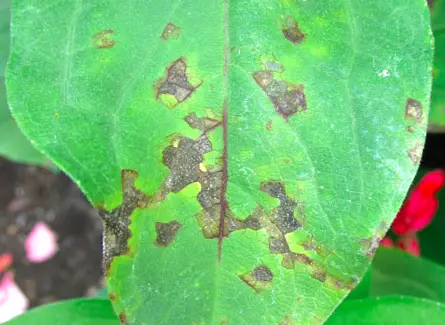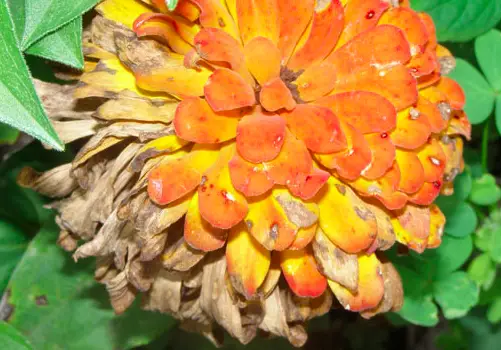If you are seeing brown leaves on your zinnias, don’t panic! There are several possible causes, and most of them can be fixed relatively easily. In this blog post, we will discuss the most common reasons why zinnia leaves turn brown, and we will provide tips on how to correct the problem.
Why Are Zinnia Leaves Turning Brown?
Brown zinnia leaves are usually caused by fungal infections, overwatering, pests, nutritional deficiency, and leaf burn. As such, browning can be caused by both environmental and care-related factors.
The solution to the browning leaves depends on the specific problem. For example, if the leaves are turning brown due to a fungal infection, you will need to treat the plant with an appropriate fungicide.
If the problem is due to overwatering, you should allow the soil to dry out completely before watering again. If pests are the cause, you will need to use an insecticide or remove the pests by hand. Lastly, if the leaves are turning brown due to leaf burn, you should move the plant to a location with filtered sunlight.
I will now cover each of these causes in more detail so that you can identify the cause of the brown leaves on your zinnias and take the appropriate corrective action.
1. Fungal Infection
One of the most common reasons for brown zinnia leaves is a fungal infection. Fungi thrive in moist environments, so they are often found in poorly-drained soils. If you suspect that your zinnias have a fungal infection, look for other signs such as white powder on the leaves, black spots, discolored leaves, or stunted growth.
If you think your zinnias have a fungal infection, it is important to treat the plant as soon as possible. Fungal infections can spread quickly, so it is best to nip the problem in the bud. The best way to treat a fungal infection is with a fungicide.
There are many different types of fungicides available, so be sure to choose one that is specifically designed for the type of fungus you are dealing with. Neem oil (Amazon link) is a good all-rounder that works well against most common fungal infections.
Once you have treated the plant with a fungicide, be sure to take steps to prevent the fungus from returning. This includes improving drainage in the soil and avoiding overhead watering.
If you live in an area with high humidity, you may also need to space your plants out more so that they have good air circulation. This will help to reduce the chances of fungal infections taking hold.

2. Leaf Burn
Leaf burn is another common reason for brown zinnia leaves. It is caused by the leaves being exposed to too much direct sunlight. The leaves will turn brown and dry out, and eventually, they will fall off the plant.
If you think your zinnias have leaf burn, the best thing to do is move them to a location with filtered sunlight. This could be a spot that gets partial shade during the day or one that is only exposed to direct sunlight for a very short amount of time.
Moving forwards, be sure to avoid exposing your zinnias to too much direct sunlight. If you live in an area with very hot summers, it is best to offer some afternoon shade. This will help to prevent the leaves from getting too much sun and turning brown.
If you cannot provide afternoon shade, you may need to water your zinnias more frequently. This will help to keep the leaves cool and prevent them from drying out and turning brown.
3. Pests
Pests are another common cause of brown zinnia leaves. Aphids, whiteflies, and spider mites are all common pests that can infest zinnias. These pests feed on the sap of the plant, which can cause the leaves to turn brown. In severe cases, the plant may be stunted or even killed.
If you think your zinnias have pests, remove them as soon as possible by hand or with an insecticide. I recommend using an organic insecticide such as neem oil to avoid harming beneficial insects such as ladybugs and bees.
Once you have removed the pests, take steps to prevent them from returning. This includes keeping the area around your plants clean and free of debris. You may also need to treat the soil with an insecticide to kill any pests that are living in it.
4. Nutrient Deficiencies
Leaf burn, pests, and fungal infections are all common causes of brown zinnia leaves. However, sometimes the problem can be much simpler – a nutrient deficiency.
Zinnias need a good supply of nutrients to stay healthy and produce vibrant flowers. If they do not get enough of certain nutrients, the leaves will begin to turn brown. The most common nutrient deficiencies that cause brown leaves are nitrogen and potassium.
If you think your zinnias have a nutrient deficiency, the best thing to do is fertilize them. Use a fertilizer that is high in potassium, such as Fox Farm Big Bloom (Amazon link). Be sure to follow the instructions on the fertilizer packaging and only apply the recommended amount.
Once you have fertilized your zinnias, they should start to recover and the leaves should begin to turn green again. However, it is important to keep an eye on them and make sure that they are getting enough nutrients in the future. This includes regularly fertilizing them and ensuring that they are planted in nutrient-rich soil.

5. Overwatering
Overwatering is another common cause of brown zinnia leaves. When the plants are overwatered, the roots cannot get the oxygen they need to stay healthy. This causes the leaves to turn brown and eventually die.
If you think your zinnias are being overwatered, the best thing to do is reduce the amount of water you are giving them. Allow the soil to dry out completely between waterings and only water when the plants are wilted.
In addition, make sure that your zinnias are planted in well-draining soil. This will help to prevent the roots from sitting in water and becoming oxygen deprived. If necessary, you can add some sand to the soil to improve drainage.
Should I Prune Brown Zinnia Leaves?
It’s completely your decision whether or not you want to prune brown zinnia leaves. Some gardeners believe that it’s best to remove them so that the plant can focus its energy on producing new growth. Others believe that the brown leaves add character to the plant and should be left alone.
Personally, I only prune if the cause of browning is a fungal infection. In this case, it’s important to remove the affected leaves so that the problem doesn’t spread. However, if the browning is due to a nutrient deficiency or overwatering, I simply leave the leaves alone.
Conclusion
In conclusion, there are many different reasons why zinnia leaves may turn brown. The most common causes are leaf burn, pests, fungal infections, nutrient deficiencies, and overwatering. Once you have determined the cause of the problem, you can take steps to fix it. This may include reducing watering, adding fertilizer, or removing pests.
Do you have experience with brown zinnia leaves? Share your tips in the comments below!
Tim is an avid gardener from the UK. He was the founder of PlantCarer.com from 2021 to Sep 2023. He sold PlantCarer.com to Aaron. He has since started his own business called Seed To Supper, which provides new gardeners all the materials you need in a box (pots, seeds, compost and instructions) to grow your own delicious and nutritious vegetables and herbs from start to finish – no garden required.









0 Comments